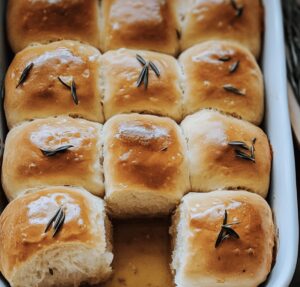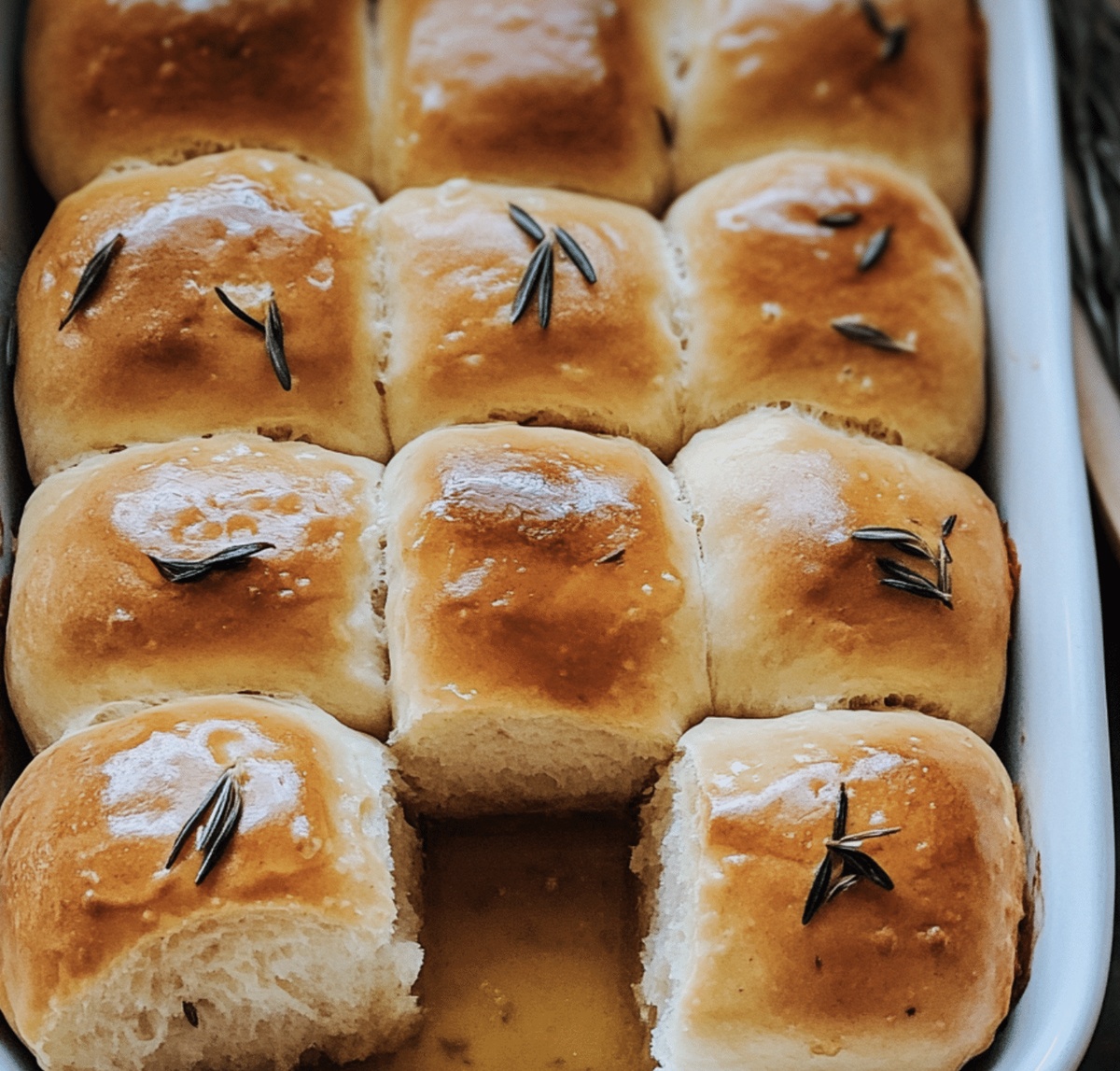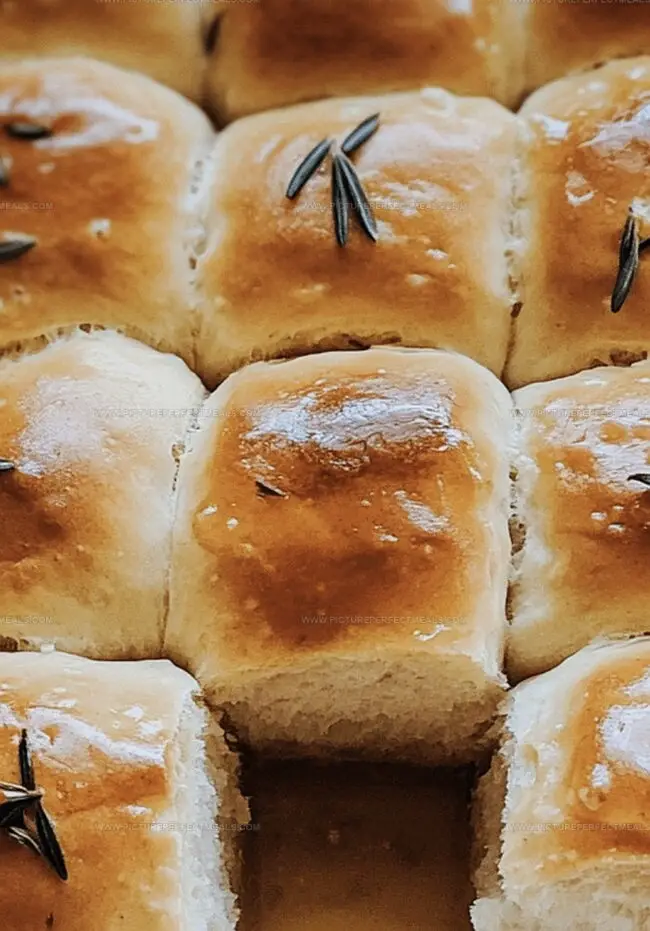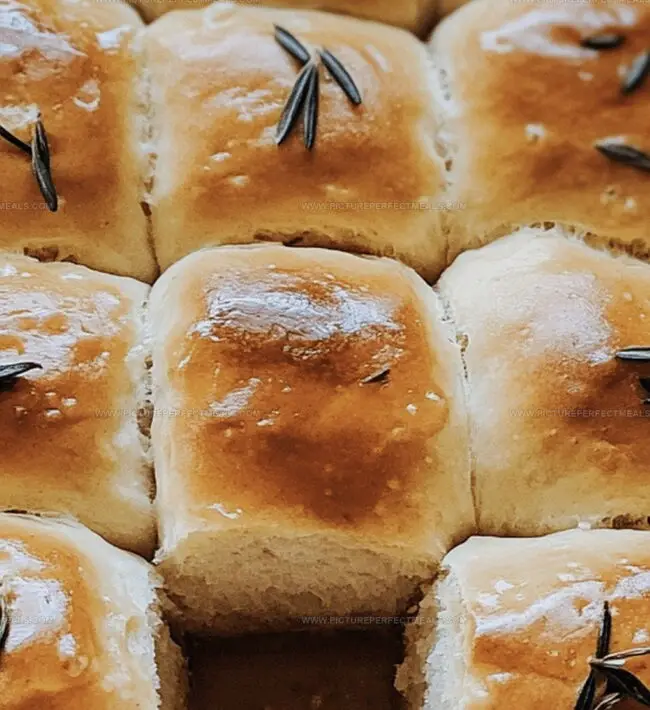Golden Rosemary Honey Butter Dinner Rolls Recipe: Fluffy Joy
My weekend gatherings always feature these mouthwatering rosemary honey butter dinner rolls that transform an ordinary meal into something special.
Soft pillows of warmth emerge straight from the oven, promising comfort in every delicate bite.
Fragrant herbs dance through buttery layers, creating a sensory experience that beckons everyone to the table.
Each roll carries a delicate balance between sweet honey notes and earthy rosemary essence.
Kneading dough becomes a meditation, connecting you with generations of home bakers who understand true nourishment.
Warm bread signals welcome, comfort, and shared moments around the table.
Let these golden, pillowy rolls become the star of your next meal.
Smart Tips for Rosemary Honey Butter Rolls
How to Keep Rosemary Rolls Fresh
What to Serve with Rosemary Dinner Rolls
Try These Styles of Rosemary Honey Rolls
Got Questions About Rosemary Honey Rolls?
Warm milk and water between 100-110°F create the perfect environment. The sugar feeds the yeast, helping it foam and become active within 5-10 minutes.
The dough should become smooth, elastic, and spring back when gently pressed. It shouldn’t be sticky or dry, but have a soft, pliable texture after 6-8 minutes of kneading.
The first rise develops flavor and allows gluten to relax, making the rolls softer. The second rise helps rolls become light and fluffy, creating a beautiful, puffy texture before baking.
Yes, absolutely! You can knead the dough by hand on a lightly floured surface. The key is consistent, gentle kneading until the dough becomes smooth and elastic.
Why Rosemary Honey Butter Dinner Rolls Are Special
What Goes in Rosemary Honey Butter Dinner Rolls
Flour and Leavening Agents:Liquid and Fat Ingredients:Seasoning and Finishing Ingredients:How to Bake Rosemary Honey Butter Dinner Rolls
Step 1: Kickstart the Yeast Magic
Grab a small bowl and mix warm milk, warm water, and sugar. Sprinkle yeast on top and let it hang out for 5-10 minutes until it gets bubbly and alive.
Step 2: Create Dough Perfection
In a large mixing bowl, combine flour and salt. Pour in the yeast mixture, add softened butter and egg. Mix until a soft dough comes together.
Knead the dough on a flour-dusted surface for 6-8 minutes until it feels smooth and stretchy. Pro tip: A stand mixer with a dough hook works like a charm for 5 minutes.
Step 3: Let Dough Rise and Shine
Transfer dough to a greased bowl, cover with a clean kitchen towel. Park it in a cozy warm spot for 1-2 hours until it doubles in size.
Step 4: Shape Rolling Goodness
Gently deflate the dough and divide into 12 equal pieces. Roll each piece into a smooth ball. Nestle these beauties into a greased 9×13-inch baking dish.
Step 5: Second Rise Celebration
Drape a kitchen towel loosely over the rolls. Let them puff up for 30-45 minutes.
Step 6: Bake to Golden Perfection
Crank the oven to 375F (190C). Bake rolls for 15-18 minutes until they turn a gorgeous golden brown.
Step 7: Whip Up Rosemary Honey Butter Goodness
While rolls are baking, mix:Step 8: Finish with Buttery Brilliance
Pull rolls from the oven and immediately brush with the rosemary honey butter. Serve warm and watch everyone swoon.
Print
Rosemary Honey Butter Dinner Rolls Recipe
- Total Time: 35 minutes
- Yield: 12 1x
Description
Homemade rosemary honey butter dinner rolls bring warmth and comfort to any gathering with their golden-brown exterior and delicate herb-infused flavor. These irresistible rolls melt in your mouth, offering pure comfort that connects families around the dinner table.
Ingredients
Main Ingredients:
- 3 ¼ cups (405g) all-purpose flour
- 1 large egg
- ½ cup (120ml) warm milk (110F/43C)
- ½ cup (120ml) warm water (110F/43C)
Leavening and Seasoning:
- 1 packet (2 ¼ teaspoons) active dry yeast
- ¼ cup (50g) granulated sugar
- 1 teaspoon salt
Fats and Additional Ingredients:
- ¼ cup (60g) unsalted butter, softened
Rosemary Honey Butter Topping:
- ¼ cup (60g) unsalted butter, melted
- 2 tablespoons honey
- 1 teaspoon fresh rosemary, finely chopped
- Pinch of salt
Instructions
- Whisk warm milk, water, and sugar in a compact vessel, then disperse yeast across the surface. Allow the mixture to bloom and become frothy for approximately 7-10 minutes.
- Merge flour and salt in a spacious mixing container. Incorporate bloomed yeast, softened butter, and egg until a cohesive dough emerges.
- Transfer dough onto a lightly dusted work surface. Manipulate and stretch the dough with rhythmic kneading motions, developing gluten structure for 6-8 minutes until texture becomes smooth and resilient.
- Nestle dough into a generously greased receptacle. Cloak with a clean fabric and position in a draft-free, temperate environment for 1-2 hours, permitting volume to substantially expand.
- Deflate risen dough by gently pressing downward. Segment into 12 uniform segments, rolling each into compact, taut spheres with seamless exterior.
- Strategically arrange dough orbs within a greased rectangular or circular baking vessel, ensuring minimal spacing between rolls.
- Drape rolls with a lightweight fabric, allowing secondary fermentation for 30-45 minutes until visibly puffy and interconnected.
- Calibrate oven temperature to 375F. Position rolls in preheated chamber, baking until surfaces transform into rich golden hues, approximately 15-18 minutes.
- Simultaneously, construct aromatic butter glaze by amalgamating melted butter, honey, finely chopped rosemary, and a pinch of salt.
- Immediately upon removing rolls, lavishly brush surfaces with herbed honey butter. Serve while radiantly warm for optimal gustatory experience.
Notes
- Yeast Activation Tip: Ensure water temperature is between 100-110°F to wake up yeast without killing it, using a kitchen thermometer for precision.
- Kneading Technique: Develop gluten by stretching and folding dough, creating tender and fluffy rolls with a smooth, elastic texture.
- Alternative Flour Options: Substitute up to 50% whole wheat flour for added nutrition, understanding it might slightly reduce softness and require extra liquid.
- Make-Ahead Strategy: Prepare dough night before, refrigerate after first rise, then shape and proof rolls next day for convenient entertaining without compromising quality.
- Prep Time: 20 minutes
- Cook Time: 15 minutes
- Category: Breakfast, Dinner, Snacks
- Method: Baking
- Cuisine: American
Nutrition
- Serving Size: 12
- Calories: 164
- Sugar: 3.7g
- Sodium: 170mg
- Fat: 6.8g
- Saturated Fat: 4.1g
- Unsaturated Fat: 2.5g
- Trans Fat: 0g
- Carbohydrates: 22.9g
- Fiber: 0.7g
- Protein: 3.4g
- Cholesterol: 20mg




Daves Miller
Contributing Chef & Culinary Educator
Expertise
Education
Sullivan University, Louisville, Kentucky
White Mountains Community College, Berlin, New Hampshire
Daves is the friendly face guiding you through flavorful, fuss-free recipes at Picture Perfect Meals.
He studied culinary arts at Sullivan University and embraced Baking and Pastry Arts at White Mountains Community College. Daves specializes in comforting meals with vibrant flavors, highlighting fresh, seasonal ingredients.